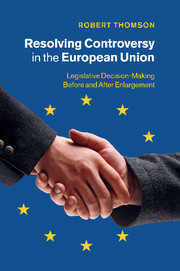 Resolving Controversy in the European Union
Resolving Controversy in the European Union Book contents
- Frontmatter
- Contents
- Figures
- Tables
- Acknowledgements
- 1 Introducing the political system of the European Union
- 2 Research design: measuring controversy spatially
- Part I Inputs
- Part II Processes
- 7 Transforming policy positions into decision outcomes
- 8 The relative power of the institutions
- 9 The relative power of the member states
- Part III Outputs
- 12 Evaluating and improving the European Union
- Appendix The selection of legislative proposals
- References
- Index
7 - Transforming policy positions into decision outcomes
from Part II - Processes
Published online by Cambridge University Press: 07 October 2011
- Frontmatter
- Contents
- Figures
- Tables
- Acknowledgements
- 1 Introducing the political system of the European Union
- 2 Research design: measuring controversy spatially
- Part I Inputs
- Part II Processes
- 7 Transforming policy positions into decision outcomes
- 8 The relative power of the institutions
- 9 The relative power of the member states
- Part III Outputs
- 12 Evaluating and improving the European Union
- Appendix The selection of legislative proposals
- References
- Index
Summary
From inputs to outputs
How are diverse policy positions transformed into decision outcomes? This chapter examines the extent to which different theories accurately predict decision outcomes in the cases selected. Chapter 1 summarized the formal decision-making rules in the Treaty of the European Union (EU) that structure the decision-making process, such as the Commission’s right to initiate proposals, voting procedures in the Council and the involvement of the European Parliament (EP). Such formalities are at best the start of an answer to the above research question. To assess the impact of formal decision-making rules, we will identify the implications of those rules for decision outcomes, given the policy demands made on each controversy. The analysis will also consider alternative accounts of the decision-making process that attribute less importance to the formal rules, and that instead focus on informal bargaining among political actors.
This chapter uses a modelling approach to compare the relevance of different explanations of the EU’s decision-making process. Each explanation is specified in such detail that it makes specific predictions of what the decision outcomes will be given the distributions of actors’ initial policy positions on the controversial issues. This approach allows the analysis to compare the accuracy of different explanatory models’ predictions of decision outcomes. The analysis also identifies the extent to which alternative models differ from each other in their predictions of decision outcomes.
- Type
- Chapter
- Information
- Resolving Controversy in the European UnionLegislative Decision-Making before and after Enlargement, pp. 159 - 187Publisher: Cambridge University PressPrint publication year: 2011


